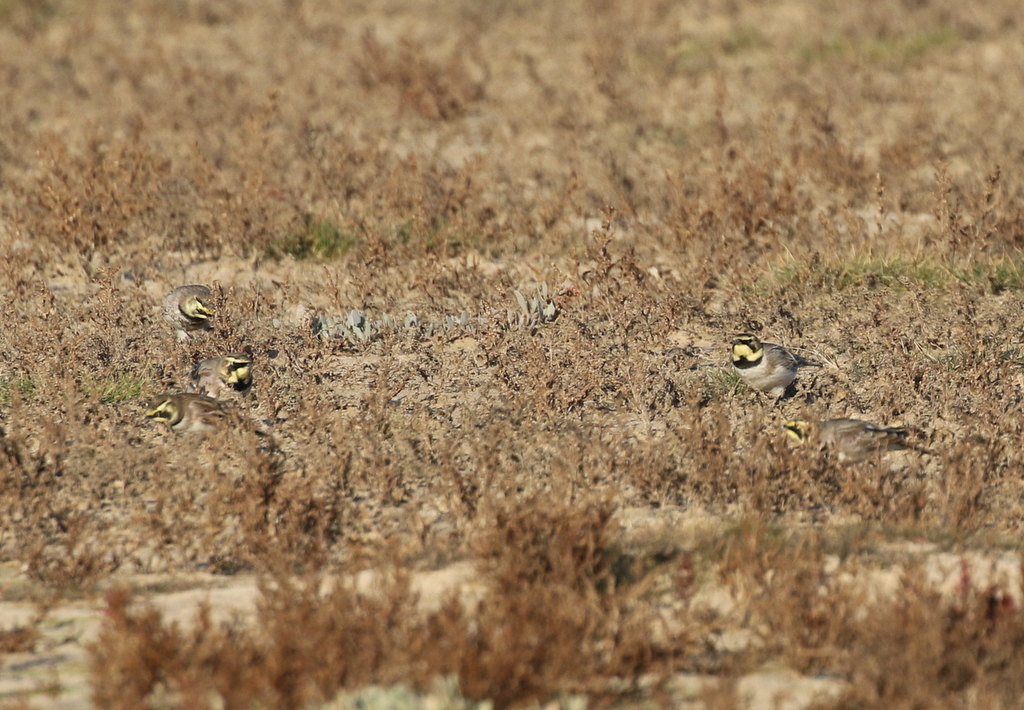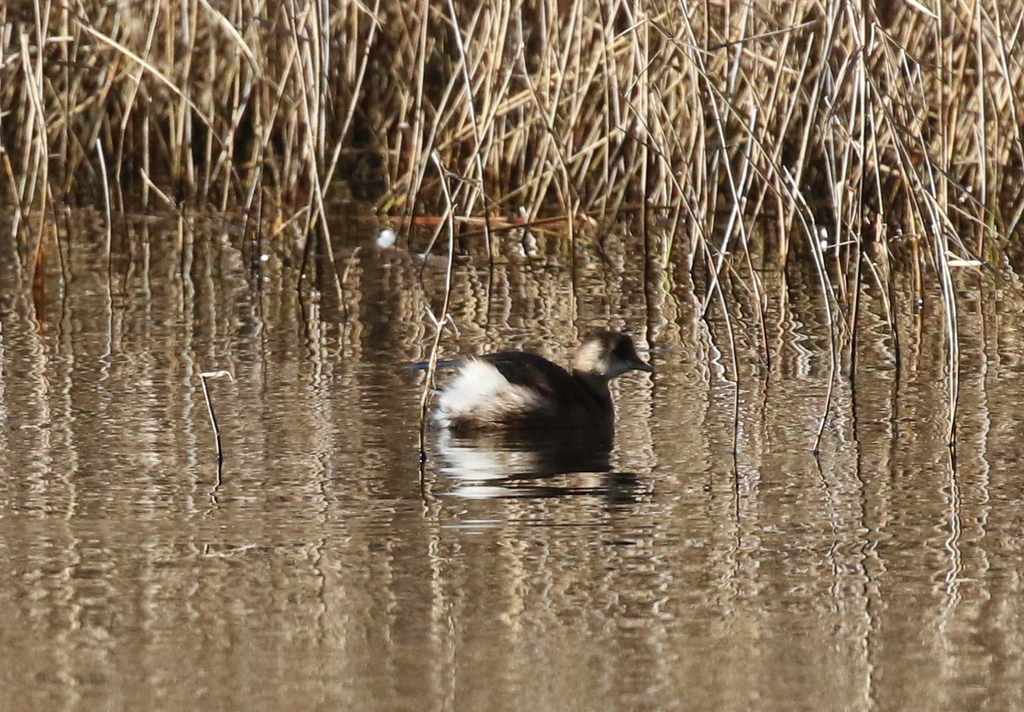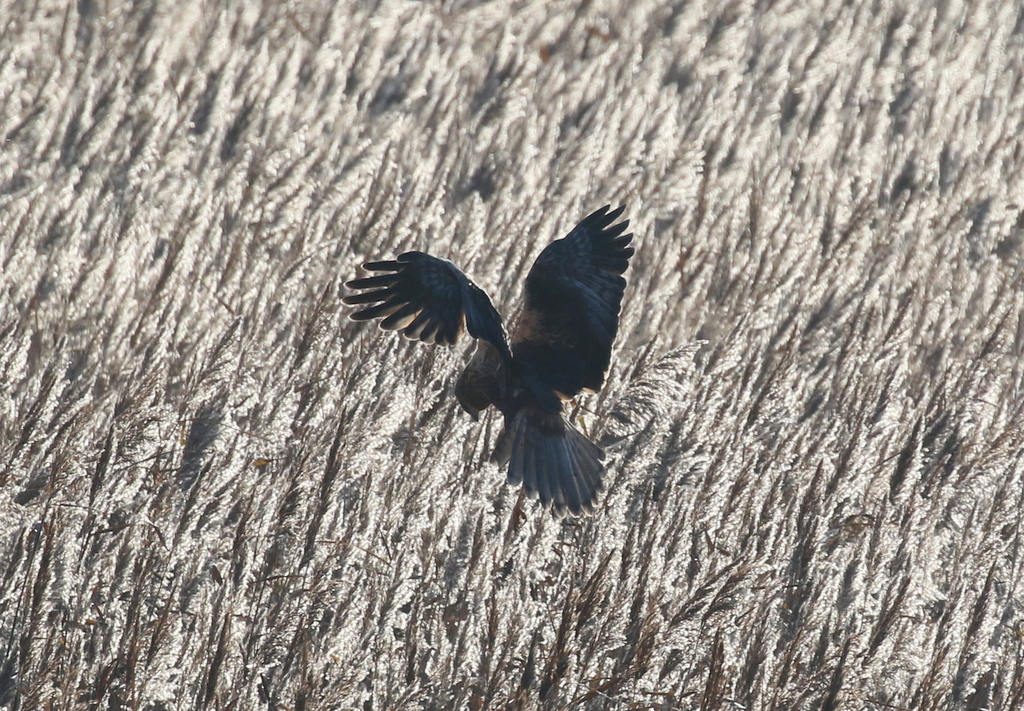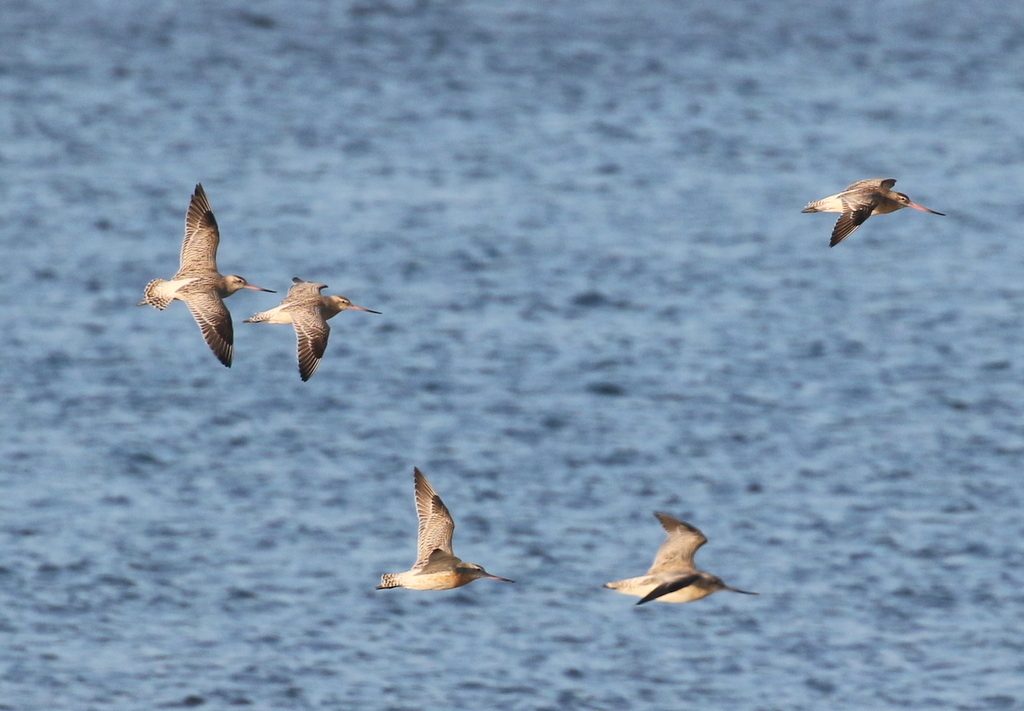Day 2 of a three day long weekend of Early Winter Tours today. After a misty start, the sun came out and the skies cleared, and it was a lovely bright sunny late autumn / early winter’s day. Great weather to be out.
It was very misty out on the grazing marshes when we arrived at Holkham and drove up along Lady Anne’s Drive. The sun was already starting to burn off the mist as we parked and got out of the car. We could see a couple of Pink-footed Geese in the field right by the north end of the Drive, along with a lone Brent Goose. Another two Pinkfeet flew over calling.

There were clearly lots of birds in the hedge on the south side of the trees, so we stopped for a closer look. The hawthorns were full of Redwings, feeding on the berries, along with a few Song Thrushes, presumably all fresh arrivals from the continent overnight, coming in for the winter. One Redwing was perched on the edge, enjoying the early sun as the mist lifted. Several then dropped down onto the grass in the middle of the grazing marsh to feed, in amongst the ubiquitous Woodpigeons.
A small group of Bullfinches flew along the hedge, flashing their white rumps. A smart pink male perched up in the hawthorns briefly, but quickly dropped back into cover. Four Greenfinches appeared in the trees nearby but quickly flew off east. Then a flash of a small pale bird flying along the brambles stretching out across the far side of the grass, turned out to be a female Blackcap once it landed and we got it in the scope.
The new café, ‘The Lookout’, wasn’t open yet, but we took advantage of the raised ground around it as a vantage point to scan the grazing marshes to the east. A couple of Stonechats perched up in the top of the reeds, waiting for it to warm up. A Common Buzzard flew across and landed on a concrete block out in the middle; nearby a second Buzzard was perched in the top of the hedge.
As we walked through pines, we could hear Long-tailed Tits calling in the trees. Out onto the edge of the saltmarsh, we turned right and walked along the path below the pines. It was rather quiet along here today, and when we got to the new cordon, erected to help protect the Shorelarks from disturbance, there was no sign of them.
The Shorelarks often like to feed on the beach too, so we continued on to look for them there. We could see a long line of Cormorants drying their wings out on the sand bar beyond. Several gulls were feeding just offshore, mainly Black-headed Gulls, flying up and down over a narrow strip of water, dipping regularly down to pick food from the surface. A couple of gulls were slightly larger, bulkier, with pure white wing tips – two adult Mediterranean Gulls. Then a much smaller gull flew in to join the same group, a dainty Little Gull flashing its dark underwings.
While scanning back and forth through the gulls, another white shape bobbing on the sea caught our eye. As we focused in, we could see it was an Avocet! Swimming out on the sea! This is not something Avocets normally do, although most waders are capable of swimming short distances if required. We assumed it had only landed briefly, but over the following 15 minutes or so we were on the beach, it remained happily out on the sea. Seemingly there were a few Avocets on the move today, with other birds seen flying along the coast, so perhaps this was just a tired migrant stopping for a rest? Whatever it was doing there, it was bizarre to see it!
With a very calm sea, there were not so many duck visible today (they were presumably feeding further out). We did find a flock of Red-breasted Mergansers closer in, off the sandbar. There were a few Gannets flying back and forth offshore too, and when we focused the scope on two distant Gannets resting on the sea, we could see one or two Guillemots on the water in front of them.
There had been a few Meadow Pipits and Skylarks flying over calling, but then we heard the Shorelarks and we turned to see them flying in to the cordoned off area on the saltmarsh behind us. We walked back round for a closer look, and when we got to where the Shorelarks were, we heard Snow Buntings calling. We looked across to the other side of the cordon to see three Snow Buntings fly in and drop down on the edge of the dunes at the back. We didn’t know where to look first!
After a look at the Snow Buntings first, we turned our attention back to the Shorelarks. Very obligingly, they flew across and landed down on the saltmarsh in front of where we were standing. They are very well camouflaged when they are feeding down in the vegetation, and they were hard to count at first, but eventually everyone who was counting managed to see all 12 of them. When they put their heads up, you can see their yellow faces and black bandit masks, and it was a perfect day for watching them today. Their yellow faces glowed in the morning sun, which was shining from behind us. Stunning!


Shorelarks are very scarce winter visitors from Scandinavia, in variable numbers from year to year, and Holkham is a very traditional site for them. They feed on the seedheads out on the saltmarsh here. Hopefully the new cordon will encourage them to remain here through the winter again.
Having enjoyed great views of the Shorelarks, we made our way back to Lady Anne’s Drive. ‘The Lookout’ café was now open, so we made a quick stop to use the facilities. A Kingfisher shot across the top of the Drive and disappeared west behind the trees, down the line of the ditch, unfortunately too quick for most to get onto it. A Sparrowhawk was perched on a post in the middle of the grazing marsh.
We walked west from there, on the inland side of the trees. We flushed lots of Blackbirds from down under the trees or the hawthorns as we went. There had clearly been a major arrival overnight from the continent, and more seemed to be arriving now, coming in through the tops of the pines. Three Jays flew across the path and one landed in the poplars.
We could hear tits in the pines and looked up to see a flock of mainly Long-tailed Tits working its way through the tops. A Treecreeper called from somewhere deep in the trees, but we couldn’t see it. A Goldcrest appeared in the pines right above our heads and dropped down to feed low down in a tree right beside us.

There were lots of Mallard on Salts Hole today, and in with them we found at least six Little Grebes, several Coot and three Tufted Duck. A small flock of Wigeon was feeding on the grass beyond, and three Egyptian Geese were calling noisily just behind them. One of the Egyptian Geese flew up into the pine tree, perhaps checking out a potential nest site already.
Two Marsh Harriers circled over the reeds in front of Washington Hide, flushing all the ducks. We could see a small flock of Shoveler circling round. As we started to walk in that direction, we looked back at Salts Hole to see two Water Rails fly out of the reeds. One flew across to the other side but the other turned back. Both disappeared straight into the reeds unfortunately, but we could then hear them squealing to each either from either side.

There were some more Long-tailed Tits in the Holm Oaks along the side of the track and we stopped to watch two Coal Tits chasing each other in and out of the trees. A quick scan from the gate overlooking the grazing marshes revealed a distant flock of Pink-footed Geese and more Wigeon out on the grass.
From up on the boardwalk to Washington Hide, we watched one of the Marsh Harriers quartering over the reeds. It hovered for a couple of seconds and looked like it was going to drop down after something, but then drifted away to the grazing marshes beyond. We were looking straight into the low sun from here – one of the disadvantages of such a nice day at this time of year – so we decided to press on west. There were a few Common Darter dragonflies still out, enjoying the late sunshine, and one was basking on the wood of the boardwalk by the track.

The pools and grazing marshes in front of Joe Jordan Hide looked rather quiet at first, but a scan of the grass to the west of the hide revealed eight Russian White-fronted Geese with the Greylags. Compared to the Greylags, the Whitefronts were noticeably smaller, with a more delicate pinkish bill surrounded with white at the base. The White-fronted Geese are just returning now for the winter, but numbers here will depend on the weather and food availability on the continent.
There were a couple of people already in the hide when we arrived, and they told us we had just missed a Great White Egret flying past. It was still almost visible away to the east of us, but hidden behind hedge. When a second Great White Egret was then flushed by a Marsh Harrier from the reeds closer to us, the first flew back in and the two of them chased round over the edge of the grazing marsh and in and out of the hedge. One eventually flew back and landed on the far side of the marshes.

On the walk back, we bumped into the tit flock again, where we had seen the Goldcrest earlier. It or another Goldcrest was still in the same tree! A Treecreeper appeared in one of the poplars above us and we watched as it worked its way out along the underside of one of the branches. It was then joined by a second Treecreeper briefly, before the two of them flew back deeper into the trees.
Back at ‘The Lookout’, a large flock of Blackbirds came in over the pines and headed off inland. Unfortunately, with the opening of the new café, the picnic tables by Lady Anne’s Drive have been removed (presumably to encourage people to frequent the new establishment!), so we decided to find somewhere else to eat our lunch. There are still some benches at Burnham Overy Staithe, which had the added advantage of a lovely view overlooking the harbour, particularly on a glorious day like today.
After lunch, we had a quick walk out along the seawall. With the tide in, there were a lot of boats sailing up and down the harbour channel and a lot of disturbance as a consequence. There were not to many waders along the sides of the channel at first – a couple of Grey Plover over the far side, and a Curlew down below us which was catching the afternoon sun.

As we got a bit further out, more waders started to appear. A couple of small flocks of Dunlin flew out of one of the side channels and across the harbour towards us. Several Bar-tailed Godwits landed out on a sandbar in the middle of the channel out towards the dunes and were joined by a few Grey Plover. When another boat sailed towards them, they flew again and came across to our side of the harbour.
Round the corner of the seawall is a muddy bay which is less disturbed by passing boats. A large flock of the Dunlin had all gathered here, feeding feverishly on the mud. Looking through we could see several Ringed Plover with them, their distinctive black ringed faces instantly setting them apart. A few more Grey Plover and Redshanks were scattered around the mud too and the Bar-tailed Godwits flew in to join them. It was nice to see all the waders together, to compare sizes, bill shapes and watch the different ways in which they were feeding.

One of the group spotted an Avocet flying across the harbour towards us. It looked like it might drop in with the other waders, but changed its mind and continued on over the seawall towards Holkham.
At the next corner on the seawall, where the path across the grazing marshes meets the bank, a large flock of Brent Geese had gathered to feed on the grass just below us. We could see several stripy-backed juveniles in with the plainer adults, which suggests they have had a better breeding season this year than last. There were also ten or so Barnacle Geese further back, most likely feral birds hopped over the wall from Holkham Park.
One of the adult Brent Geese stood out from the others – it had a much more striking white collar, a slightly paler flank patch and appeared slightly darker, more blackish overall. It is a hybrid Black Brant, an intergrade between two forms of Brent Goose, between our regular Dark-bellied Brent and a Black Brant from NE Siberia or NW North America. It is an old friend – it returns to exactly the same fields every winter, showing us just how site faithful all these geese are.

The afternoon was getting on and had we wanted to fit in one more thing before it got dark, so we headed back to the car and drove along the coast to the other side of Wells. As we walked down the track heading towards the coast, we flushed several Goldcrests which flew along the hedge ahead of us. There were also a few Blackbirds and Redwings which flew out of the hedge calling, presumably feeding up on the berries after their journey across from the continent. Another large flock of Brent Geese was feeding in the winter wheat here, chattering noisily.
When we got down to the edge of the saltmarsh, there were already a few people gathered here. A Merlin was perched up on the top of a very distant bush, having just been flushed by a wildfowler walking around out on the marshes.
Apparently a male Hen Harrier had flown past before we arrived, but then a second one appeared perched on a bush, also rather distant though clearly visible through the scope. A ringtail Hen Harrier flew in from the east, across the back of the saltmarsh, and dropped straight into the grass, straight to bed. With the clear weather, it appeared the birds had been making the most of it, hunting late rather than coming in early and flying around before going in to roost. The first male Hen Harrier flew back in from the west, and the second came up so we could see the two males flying round together
A large skein of Pink-footed Geese came over from the fields behind us calling, and flew out across the saltmarsh and landed on the flats beyond to roost. One of the group, looking the other way from the rest of us, spotted another Merlin coming in from behind us too. It came over our heads, turned out over the saltmarsh and we watched it fly across against the sky, before it dropped down and landed on a bush, where we got it in the scope. It was much closer than the first one we had seen, but the light was starting to go now.
A Green Sandpiper flew west calling, but we couldn’t see it in the gathering gloom, so we decided it was time to call it a day and head back.
















